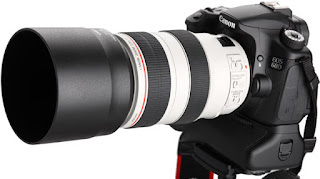Like all hobbies, there is an abundance of gadgets, gizmos, do-dads, and other accessories that are available to photographers. Over the years, I have succumbed to the Photographers GAS - Gear Acquisition Syndrome. I have two cameras, 9 lenses, multiple filters, two tripods, and several different camera bags to lug all that gear around. I have a closet at home dedicated to my camera gear.
There is one item I have maintained is unnecessary and up to this week, I didn't own one. A UV
 |
| UV Filter |
filter is basically a piece of clear glass that goes on the end of a lens. As its name implies, it blocks UV rays from entering the lens. In the old days when photographers used film that was sensitive to UV rays, the UV filter could keep photos from having a nasty blue tint. Today's digital cameras are not impacted by UV rays. Having a UV filter to block UV rays is a waste of time and money.
Any time you add more glass to a lens you risk degrading the quality of your images. Like a chain with a weak link, a lens is only as good as its worst piece of glass. Put a cheap UV filter on an expensive lens and you may get poor quality images, especially when shooting into the sun or other bright light sources.
The one reason I hear most often for using a UV filter is to protect the front element (glass) on the lens. If the UV filter gets scratched you can replace it. If the front element of a lens is scratched you are looking at an expensive repair.
This brings me to why I bought a UV filter. I'm going to be shooting in deserts in Nevada and California in a few weeks. There is a possibility of blowing sand, which can ruin glass on a lens. I will bring the UV filter with me and if the conditions are such that I need that additional protection, I'll use it.
One piece of equipment I tend to use almost all the time is a lens hood. While it may not protect
 |
| Lens Hood |
from flying sand, it can protect the front of the lens from other objects, such as tree branches, rock outcroppings, and other dangerous objects found along hiking trails. The hood is primarily designed to block light from hitting the front element of the lens, which can cause flares in an image. It is also useful as a shield in the woods where June and I spend a lot of time.
As I said earlier, I have a lot of other gear. I'll review some of that in future posts.
Watch for desert photos in a few weeks.








